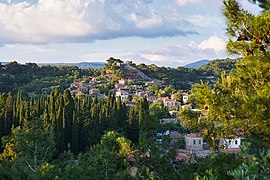|
Adatepe, Ayvacık
Adatepe is a village in the Küçükkuyu belde, in Ayvacık District of Çanakkale Province in northwestern Turkey.[1] Its population is 396 (2021).[2] The village was revived in the 1980s when the traditional stone houses were restored by people seeking to escape city life. LocationThe village is situated 280 m (920 ft) above sea level on the western foothill of Mount Ida (Turkish: Kaz Dağı) north of Edremit Gulf in Biga Peninsula.[3] It is 105 km (65 mi) from the province center Çanakkale, 35 km (22 mi) from district center Ayvacık. HistoryUp on a hill overlooking the environs and the Edremit Gulf with the islands off Ayvalık and Lesbos, a historical site is situated with a stone chamber and water-filled cistern attributed as a Zeus altar. It is believed that according to Homer's epic poem Iliad, king of the gods Zeus watched the Trojan Wars from this place.[4] Historically, the village was co-inhabited by Greeks in Turkey and Turks.[3] In 1905, around 600 Orthodox Greeks lived in the village, where a church named "Koimēsis tēs Theotokou" (Greek for "Dormition of the Mother of God") stood. The village was named Adatepe in 1912.[5] It was one of the places in Turkey where Greeks and Turks lived together and shared their cultures.[3][6] Locals reported there was a continued Turkish tradition since Seljuk times in the village as well as a Greek lifestyle the Turkish population lived with tin the Greek structures.[6] During the population exchange between Greece and Turkey by 1924, Muslim Cretan Turks settled replacing the Greek Orthodox population in the village.[4][6] VillageThe buildings in the village have Greek and Turkish architecture.[6] The original houses in the village are made of stone, and have two stories in general. All houses have a courtyard and a garden. The village is surrounded by olive groves. In the 1980s, a group of people, who escaped the big city life, came to Adatepe, which was about to turn into a ghost town towards the end of the 1980s.[6] People from Ankara, İzmir and mostly from Istanbul purchased buildings, which could be regarded as ruined, and converted them into living spaces by keeping their traditional Greek and Turkish architecture.[6] Today, the newcomers and the locals live in harmony.[4][6] The total houses in the village number 380,[7] and Adatepe was declared in 1989 an urban protected area of first grade, being the only one with this status in the region.[3][4]  EconomySome of the more than a hundred restored stone buildings are used as tourist accommodation. Around two hundred thousand tourists visit Adatepe yearly.[6] In Küçükkuyu, there is the Adatepe Olive Oil Museum located near the village,[7] which produces cold-pressed olive oil and olive oil-based soaps scented with lavender, laurel and rosemary.[8] The olive-based diverse products, of which packagings are adorned with a Greek girl picture,[7] are also exported.[9] ReferencesWikimedia Commons has media related to Adatepe.
|
||||||||||||||||||||||||||


